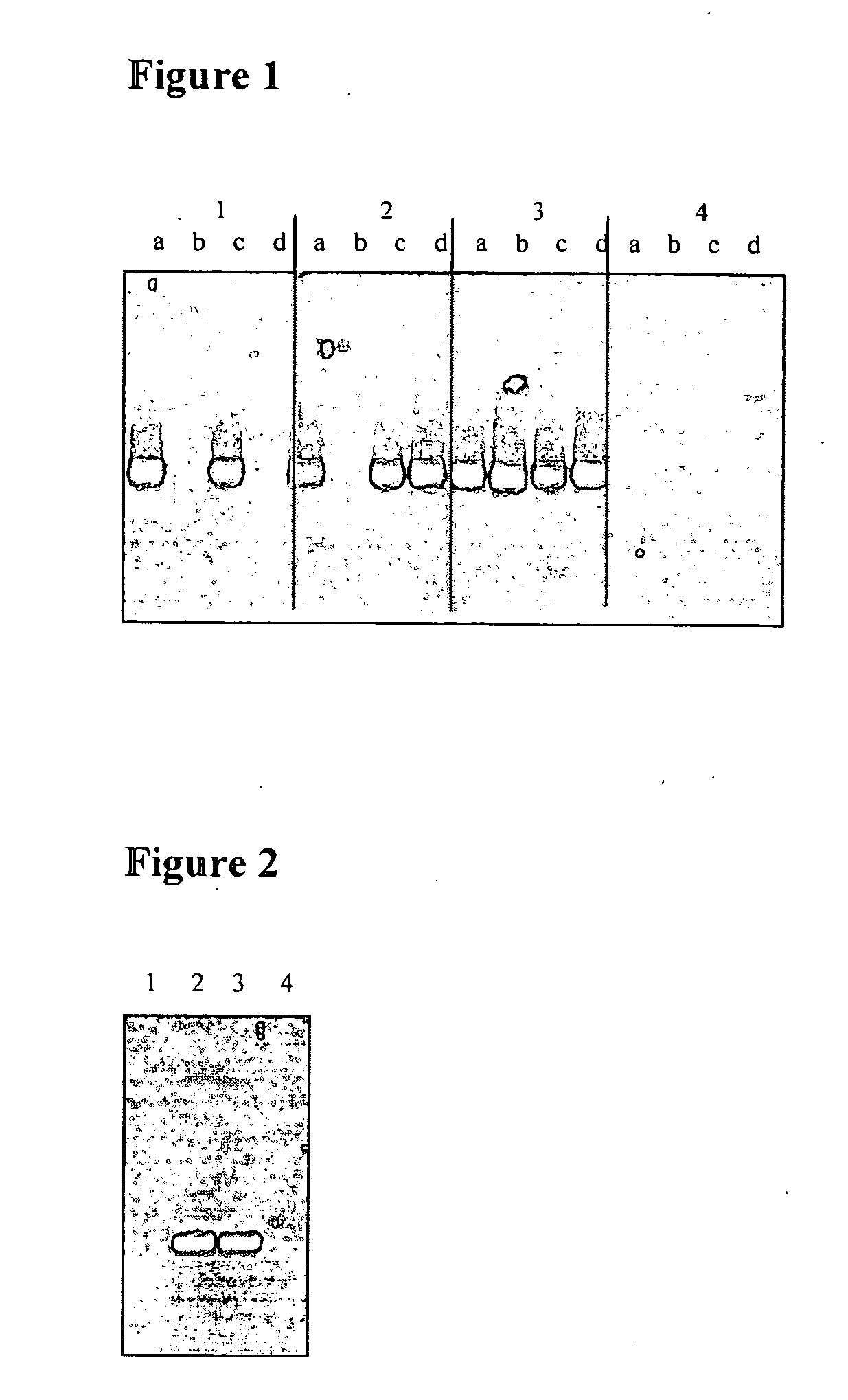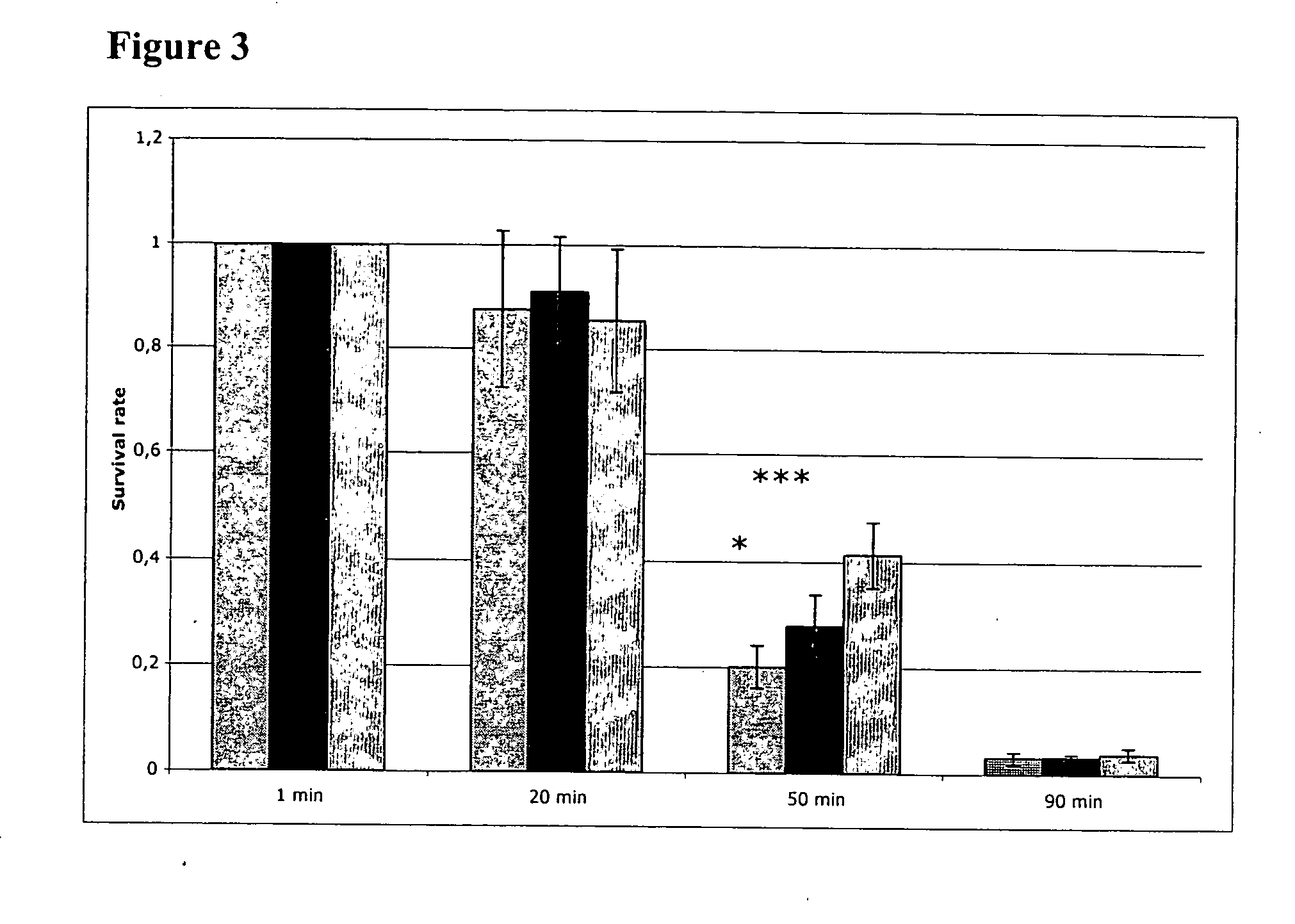Method and use of a lactic acid bacteria with increased acid tolerance
a technology of lactic acid bacteria and acid tolerance, which is applied in the field of methods and uses, can solve the problems of reducing the ability of animals to absorb nutrients, unsuitable for harmful organisms, and unfavorable oxygen-requiring microorganisms
- Summary
- Abstract
- Description
- Claims
- Application Information
AI Technical Summary
Benefits of technology
Problems solved by technology
Method used
Image
Examples
example 1
Curing of pLR585 From DSM 17686
[0023]Plasmid curing by protoplast formation and regeneration was conducted essentially as described in Vescovo et al. (Vescovo, M., Morelli, L., Cocconcelli, P. S., and Bottazzi, V. 1984. Protoplast formation, regeneration and plasmid curing in Lactobacillus reuteri. FEMS Microbiol Lett 23:333-334). An overnight culture of Lactobacillus reuteri DSM 17686 was diluted to OD600=0.1 in a 10 ml MRS culture (Oxoid, Lenexa, Kans., USA) and grown at 37° C. until OD600=0.7-0.8. Cells were collected by centrifugation at 3000×g for 10 minutes and washed in 10 ml Nanopure water. Cells were collected again by centrifugation and re-suspended in 2 ml of protoplast buffer (0.2 M phosphate buffer, 0.5 M sucrose, 20 mM MgCl2; pH 7.0). The cells were mixed with an equal volume of 10 mg ml−1 lysozyme in protoplast buffer and incubated at 37° C. for 1 h. Protoplasts were harvested by centrifugation at 3000×g for 15 minutes and washed with 20 ml protoplast buffer. Protopla...
example 2
Determination of Minimal Inhibitory Concentrations of Lincomycin
[0026]The bacteria were grown in MRS broth for 16 h at 37° C. After dilution to 105 cfu m−1, 1 μl of each bacterial strain was spotted on MRS plates containing lincomycin or clindamycin (concentrations 0, 0.125, 0.25, 0.5, 1, 2, 4, 8 and 16 μg ml−1). After adsorption of the drops, the plates were incubated in anaerobic atmosphere at 37° C. for 24 h. The MIC was defined as the lowest antibiotic concentration for which there was no visible bacterial growth. MICs to tetracycline were tested with Etest (AB Biodisk) on bacteria growing on MRS agar (Oxoid) plates according to the instructions from the manufacturer.
Result:
[0027]The curing of pLR585 resulted in a decrease of MIC from >16 to 0.25 μg ml-1 lincomycin, close to the level of the negative control DSM 20016. The already very low MIC value for clindamycin was not changed. Also the MICs to tetracycline were tested with E-test and found to be 12-16 μg ml-1 for DSM 17938 ...
example 3
Fermentation Pattern and Reuterin Production
[0028]Fermentation patterns were determined using api 50 CHL (bio-Mérieux) according to the instructions from the manufacturer. To detect the reuterin production, the bacteria were first grown for 48 h on MRS plates (inoculated as streaks). The plates were then overlayed with 500 mM glycerol agar (1% agar) and incubated at 37° C. for 30 min. Reuterin was detected by addition of 5 ml 2,4-dinitrophenylhydrazine (0.1% in 2 M HCl). After 3 min incubation, the solution was poured of and 5 ml 5 M KOH was added. Red zones around the colonies show that reuterin has been produced.
Result:
[0029]The fermentation pattern of DSM 17938 was compared with DSM 17686 and ATCC 55730 using API 50 CHL and no differences could be detected. All strains fermented L-arabinose, ribose, galactose, glucose, maltose, lactose, melibiose, saccharose, raffinose and gluconate and were negative for the rest of the tests. Also the production of reuterin was of the same magni...
PUM
| Property | Measurement | Unit |
|---|---|---|
| Volume | aaaaa | aaaaa |
| Mass | aaaaa | aaaaa |
| Acidity | aaaaa | aaaaa |
Abstract
Description
Claims
Application Information
 Login to View More
Login to View More - R&D Engineer
- R&D Manager
- IP Professional
- Industry Leading Data Capabilities
- Powerful AI technology
- Patent DNA Extraction
Browse by: Latest US Patents, China's latest patents, Technical Efficacy Thesaurus, Application Domain, Technology Topic, Popular Technical Reports.
© 2024 PatSnap. All rights reserved.Legal|Privacy policy|Modern Slavery Act Transparency Statement|Sitemap|About US| Contact US: help@patsnap.com









